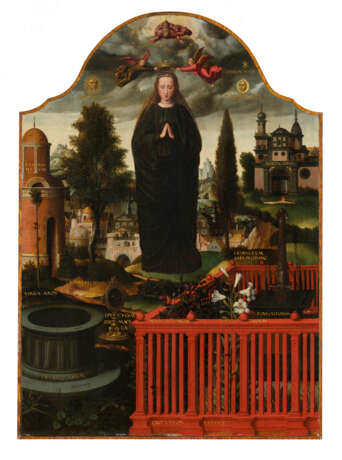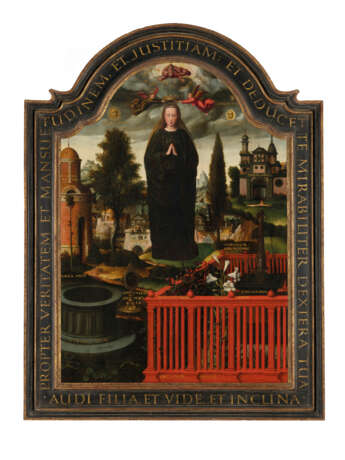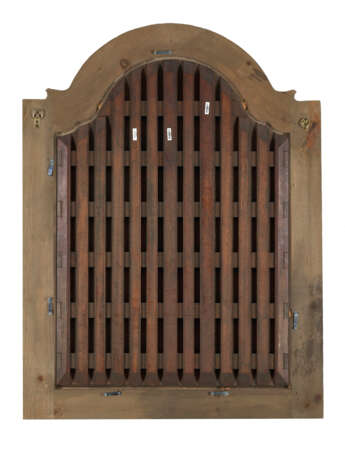ID 1071553
Лот 9 | PIETER CLAEISSENS L'ANCIEN (PAYS-BAS MÉRIDIONAUX VERS 1499/1500-1576 BRUGES)
Оценочная стоимость
€ 120 000 – 180 000
L'Immaculée Conception
huile sur panneau, chantourné dans la partie supérieure
86,5 x 62 cm. (34 1⁄16 x 24 7⁄16 in.)
inscrit 'TOTA. PVLCRA. ES. AMICA. MEA. ET. MACVLA. NON. EST IN. TE', 'STELLA. MARIS', 'ELECTA. VT. SOL', 'PVLCRA. VT. LVNA', 'TVRRIS / DAVID', 'PORTA CELI', 'CIVITAS DEI', 'CEDRVS. EXAL. EX. AL / TATA. IN. LIBANO', 'OLIVA. SPECIOSA', 'VIRGA. ARON', 'SPECVLVM / SINE MACV / LA', 'PLANTACIO. ROSE', 'FONS. ORTORVM.', 'SICVT LILIVM', 'PVTEVS AQVARUM', 'ORTVS. CONCLVSVS' (de haut en bas, de gauche à droite)
Provenance
Collection particulière, Espagne.
Vente anonyme, Christie's, Londres, 8 décembre 1995, lot 11 (comme 'Ambrosius Benson').
Rob Smeets, Genève.
Collection particulière européenne.
Exhibited
Venise, Palazzo Fortuny, TRA. Edge of Becoming, 4 juin-27 novembre 2011 (comme 'Pieter Claeissins [sic]').
Maastricht, Bonnefanten Museum, en prêt entre 2015 et 2020.
Bruges, Groeningemuseum Brugge, Forgotten Masters. Pieter Pourbus and Bruges Painting from 1525 to 1625, 13 octobre 2017-21 janvier 2018, n°52 (comme 'Pieter II Claeissens').
Further Details
PIETER CLAEISSENS THE ELDER, THE IMMACULATE CONCEPTION, OIL ON PANEL, SHAPED TO THE TOP, INSCRIBED
This highly unusual painting is an inventive representation of the Immaculate Conception of the Virgin, the idea that Mary herself was brought into being by the power of God rather than physically conceived. This doctrine freed her of Original Sin, which was seen to be essential to her pre-ordained role as Christ’s mother.
In the Twelfth and Thirteenth Centuries the issues surrounding this idea became a key part of theological debate. However, the subject did not become widespread in painting until the Sixteenth Century. This late appearance is likely more to do with the difficulty of representing so abstract a concept than the controversial nature of the debate. What is now seen as the traditional iconography of the Immaculate Conception, the young Mary robed in blue and white with twelve stars around her head, the sun and the moon beneath her feet and often standing on a serpent to symbolise her role as the Second Eve, did not fully evolve until the mid-Seventeenth Century, when it was closely linked with the Counter Reformation. Prior to this, artists drew heavily on Old Testament texts for their imagery, notably from the Song of Songs, whose protagonist, the Shulamite Maiden, came to be associated with Mary in the Middle Ages.
The complex symbolism of Pieter Claeissens’ (c. 1499/1500-1576) painting is almost all drawn from the Song of Songs. These are integrated with great sophistication into the landscape, though Latin inscriptions from the biblical text are still included, allowing for greater accessibility to the underlying theology. This form of representation evolved around 1500 and was spread by engravings in Books of Hours. In these engravings the Virgin was simply surrounded by her symbols, identified by inscriptions on banderols. Early examples of a setting in a landscape can be found in illuminated manuscripts, such as the Grimani Breviary (fig. 1), to which Claeissens’ painting is seemingly indebted.
At the top of the present composition God the Father can be seen, accompanied by the words ‘TOTA PVLCRA ES AMICA MEA ET MACVLA NON EST IN TE’. Taken from the Song of Songs (4, 7), this speaks to the Virgin’s purity, ‘Thou art all fair, my love, there is no spot in thee.’ The figure of the Virgin, eyes directed downwards, descends from God to Earth, passing between the sun and the moon, which are accompanied by the inscriptions ‘ELECTA VT SOL’ and ‘PVLCRA VT LVNA’, ‘clear as the sun’ and ‘pure as the moon’ (6, 10).
The landscape below is laid out almost as a map. To the right, an ornate Renaissance building is labelled as the ‘PORTA CELI’, (the ‘gates of heaven’), a reference to Jacob’s dream in the Book of Genesis (28, 17), whilst to the left the ‘TVRRIS DAVID’, (‘Tower of David’), stands tall. This latter once again comes from the Song of Songs (4, 4). Mary is further flanked by two trees: to the left the ‘OLIVA SPECIOSA’, the olive tree, ancient symbol of peace, and to the right a ‘CEDAR EXALTATA IN LIBANO’, (‘a cedar raised up in Lebanon’), a reference from the apocryphal book Ecclesiasticus (24, 17). Behind these extends the ‘CIVITAS DEI’, the City of God (Psalms, 87, 3).
Perhaps the most interesting symbolism, and that which Claeissens seems to take the most pleasure in detailing, is in the foreground. Here the red fence encloses a garden, in which lilies and roses grow before a fountain. The words ‘ORTUS CONCLUSUS’ (‘garden enclosed’) on the fence below are a well-known reference from the Song of Songs (4, 12) ‘a garden enclosed is my sister, my spouse’. The lilies are labelled ‘SICUT LILIUM’, taken again from the Song of Songs (2, 2): ‘I am [the rose of Sharon, and] the lily of the valleys’, whilst the quotation beneath the roses ‘PLANTACIO ROSE’ comes from the apocryphal Book of Ecclesiasticus (24, 18), and means simply a ‘plantation of roses’. Both flowers are iconographically connected with the Virgin and are seen as symbols of her virtue. The most direct reference to Mary’s purity, however, is the richly decorated mirror at lower left. This is the ‘SPECULVM SINE MACVLA’, the "spotless mirror" from the Book of Wisdom (7, 26), ‘For she is a reflection of eternal light, a spotless mirror of the working of God, and an image of his goodness.’ Finally there are the fountain in the garden and the well at lower left, which are both taken from the same verse in the Song of Songs, ‘a fountain of gardens, a well of living waters and streams from Lebanon’ (4, 15). Here inscribed ‘FONS ORTORVM’ and ‘PVTEVS AQVARVM’.
At the time of the 1995 sale, the present painting was attributed to Ambrosius Benson (c. 1495/1500-1550), however several distinct elements speak to Claeissens being the true author of the work. Notably, the Renaissance architecture, which appears regularly in his oeuvre but is absent from that of Benson. In addition to this the physiognomy of the Virgin, with the elongation of her face and the broad forehead, is highly representative of the female models in Claeissens paintings. The same is true for the hands, with their disproportionately long fingers. Lastly, the colouring of the landscape is typical for the artist. The pinks and beiges, the bare areas of grassy or sandy hills alternating with refined, detailed landscape-images, and the white highlights in the tree trunks are all highly characteristic. It should be noted that at some point the Virgin’s initial black robes were over-painted in red and blue. It was decided to remove this later addition after the 1995 sale, returning Mary to her original, elegant simplicity.
| Техника исполнения: | Масло на панели |
|---|---|
| Художественный стиль: | Старые мастера |
| Место происхождения: | Бельгия, Западная Европа, Европа |
| Категория аукционного дома: | Картины |
| Техника исполнения: | Масло на панели |
|---|---|
| Художественный стиль: | Старые мастера |
| Место происхождения: | Бельгия, Западная Европа, Европа |
| Категория аукционного дома: | Картины |
| Адрес торгов |
CHRISTIE'S 9 Avenue Matignon 75008 Paris Франция | ||||||||||||||
|---|---|---|---|---|---|---|---|---|---|---|---|---|---|---|---|
| Предосмотр |
| ||||||||||||||
| Телефон | +33 (0)1 40 76 85 85 | ||||||||||||||
| Факс | +33 (0)1 40 76 85 86 | ||||||||||||||
| Условия использования | Условия использования | ||||||||||||||
| Транспортировка |
Почтовая служба Курьерская служба Самовывоз | ||||||||||||||
| Способы оплаты |
Банковский перевод | ||||||||||||||
| Часы работы | Часы работы
|





